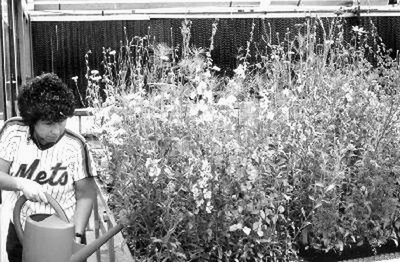April 18, 2002
Wildflower seed mixes full of weeds
The seed packets have labels with romantic-sounding names such as meadow mixture and wedding wildflowers, while others tout backyard biodiversity and make reference to Earth Day. When growing 19 such packets of wildflower mixes, however, UW researchers found that each contained from three to 13 invasive species and eight had seeds for plants considered noxious weeds in at least one U.S. state or Canadian province.
And what makes it nearly impossible for gardeners who want to be conscientious is that a third of the packets listed no contents and a little more than another third had inaccurate lists. Only five of the 19 correctly itemized everything.
“I can’t recommend using any wildflower seed mixes,” says Lorraine Brooks, who did the work at the UW’s Center for Urban Horticulture while earning her bachelor’s degree.
Brooks found the least unruly of the wildflower mixes was a packet in which only 30, or 28 percent, of the 106 plants that sprouted and produced flowers were invasive. Among the worst was a mix in which 100 percent of what flowered was invasive. There were 200 plants of only three species in that packet, which was labeled “native.” Of the three species, only one is believed to be native to the Pacific Northwest and it represented just 1 percent of the mix. Two other mixes contained not one but two noxious weed species.
Brooks and Sarah Reichard, UW assistant professor of forest resources, said gardeners are better off using their favorite plants, or seeds for their favorites, in order to control what’s grown in their yards.
In Washington, the state and 49 local weed control boards maintain lists of invasive species and noxious weeds. Depending on how serious a threat is posed by a species and how widespread it already is, weed managers may prohibit its sale and demand landowners eliminate it. Other species fall into categories in which landowners are asked to prevent the plant from going to seed so it can’t spread.
Gardeners might be surprised at the number of flowers that are readily available for sale and use that are considered invasive or noxious. For instance the wildflower most commonly observed as part of the mixes was the popular bachelor’s button (Centaurea cyanus), germinating in beautiful hues of pink and blue from three-quarters of the packets tested. Bachelor’s button might be fine if kept confined to one’s own yard but it’s invasive — that is, it outcompetes other plants — when it gets into native grasslands and prairies.
It hasn’t been named a noxious weed but it is on the state’s “education list” in the hope that property owners will become knowledgeable about the risks of growing it, says Reichard, who serves on the committee that considers changes proposed for the state’s list.
Yellow toadflax (Linaria vulgaris), on the other hand, is listed as a noxious weed in Washington, Oregon, Idaho and 11 other states and provinces. Colorado, for example, classifies it among the top-10 prioritized noxious-weed species, those that are most widespread and cause the greatest impact.
With yellow flowers tinged with orange that resemble snapdragon blossoms, toadflax was found in four of the wildflower mixes. Only one listed it. All four of the mixes are produced in King County where the plant is a “principal weed for control,” an even stronger designation than the state’s listing of it as a Class C noxious weed.
Even labels that refer to wildflowers as native should be avoided because everything is native to someplace, but that place may not be where you live, Reichard says. Just think about the differences in plants between Eastern and Western Washington, she says.
The 19 packets tested were produced by Burpee, Ed Hume, Lake Valley Seed, Lilly Miller, Molbak’s, Napa Valley Wildflower, Nature’s Garden Seed Co., and Sundance. Seventeen were purchased and two were gift items, including one from the World Wildlife Fund (WWF).
Handed out as fund raising thank-yous by the WWF and other environmental and charitable groups, and bearing labels that refer to pastures, meadows and native flowers, these mixes may even make people think they are suitable for areas next to woodlands, fields or prairies, Brooks says.
“But that would be a big mistake.”
A wild, wild world
As a UW undergraduate research project, Lorraine Brooks grew the contents of 19 different packets of wildflower mixes for 24 weeks. She was able to identify 84 species.
Four of the species are listed as noxious weeds in at least one state or Canadian province, as well as being considered invasive. They were common yarrow, Achillea millefolium; dame’s rocket, Hesperis matronalis; redroot pigweed, Amaranthus retroflexus; and yellow toadflax, Linaria vulgaris.
Thirty-five others are listed as invasive and included baby’s breath, Gypsophila elegans; bachelor’s buttons, Centaurea cyanu; Black-eyed Susan, Rudbeckia hirta; blue flax, Linum perenne; California poppy, Eschscholzia californica; cosmos, Cosmos bipinnatus; cow cockle, Vaccaria hispanica; crimson clover, Trifolium incarnatum; forget-me-not, Myositis sylvatica; poor man’s weatherglass, Anagallis arvensis; wild lupin, Lupinus perennis; doubtful knight’s spur, Consolida ajacis; and Mexican hat, Ratibida columnifera.
Weeds on the Web
Check out Washington’s noxious weeds at http://www.wa.gov/agr/weedboard/ and Western invasive species at http://invader.dbs.umt.edu/.
For information specific to King, Pierce and Snohomish counties try:
http://dnr.metrokc.gov/wlr/lands/weeds/index.htm
http://piercecountyweedboard.wsu.edu/
http://www.co.snohomish.wa.us/publicwk/roads/roadmaint/noxiousweeds.htm

